Swiss hazelnuts in check - a climate-friendly alternative?

Why do we need Swiss hazelnuts? We firmly believe that hazelnuts can make a significant contribution to climate-friendly and sustainable agriculture. For this reason, together with the farmer Stefan Gerber, we have developed the first hazelnut plantation in the canton of Zurich established. But what does it really look like? Are Swiss hazelnuts really more climate-friendly than those that come from the main growing countries such as Turkey or Italy? What is the environmental impact of a bag of Swiss hazelnuts? And how much CO2 can be stored in the soil through cultivation? We did the practical test and carried out a life cycle assessment. myclimate have them created. The results of the report are surprising on various levels.
Cultivation is mainly responsible for the environmental impact
From the field to the plate - we looked at the entire life cycle of Swiss hazelnuts, including all intermediate steps such as cracking, packaging, transportation and disposal. Similar to what we have already seen with other productscultivation is primarily responsible for the environmental impact. 79 percent of total greenhouse gas emissions and 95 percent of the total environmental impact are attributable to the cultivation phase, as the following figure clearly illustrates. Packaging and transportation are clearly secondary in this context.
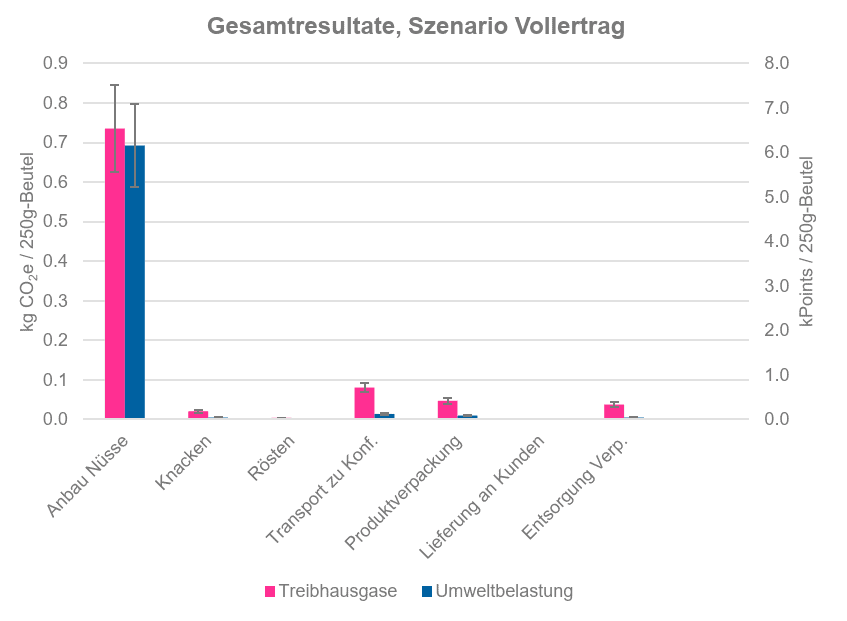
An important note at this point: Stefan Gerber only planted the hazelnut trees in Mettmenstetten in 2021. In our measurement two years later (2023), the harvest of around 50 kilograms of cracked nuts was therefore still very small. We therefore used a scenario to prepare the life cycle assessment: We assume that the hazelnut plantation will produce an average yield of around 4 tons per year from 2028 onwards, although this assumption is calculated rather conservatively. On this basis, we can already make a comparison with cultivation in Turkey and Italy.
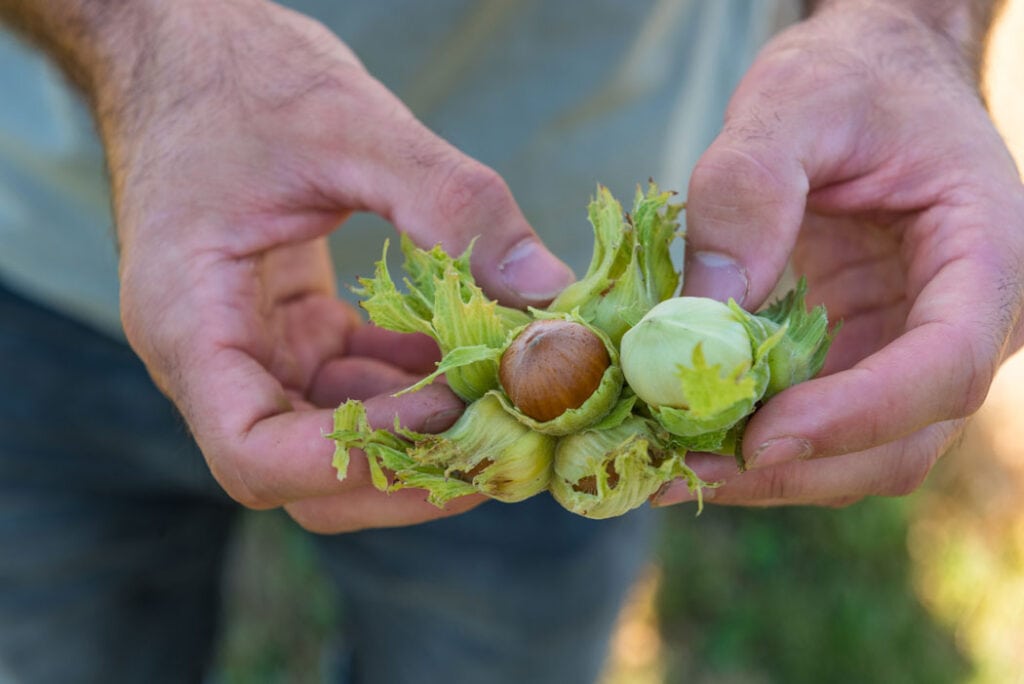
Absolute environmental impact lowest in Mettmenstetten...
If we look at the absolute environmental impact per hectare, Stefan Gerber's plot in Mettmenstetten performs best. It causes the lowest greenhouse gas emissions. However, the yield, i.e. the number of kilograms of hazelnuts per hectare, differs, as the calculation in the following section shows.
... but not per kilogram of hazelnuts
In Italy, an average of 1,456 kg of hazelnuts can be harvested per hectare, while we assume a value of 1,333 kg per hectare for cultivation in Mettmenstetten. Therefore, the cultivation in Italy with 9.4 kPoints* per kilogram of raw hazelnuts performs better than that in Mettmenstetten with 10.6 kPoints. At 12.4 kPoints, cultivation in Turkey has the highest environmental impact. In Italy and Turkey, too, cultivation accounts for the largest share of the environmental impact. The greatest impact occurs on site at the plantation ("direct influences").
*kPoints are the unit of measurement used in life cycle assessments to quantify environmental impacts (such as greenhouse gas emissions, water or energy consumption). The lower the kPoints value, the lower the environmental impact.
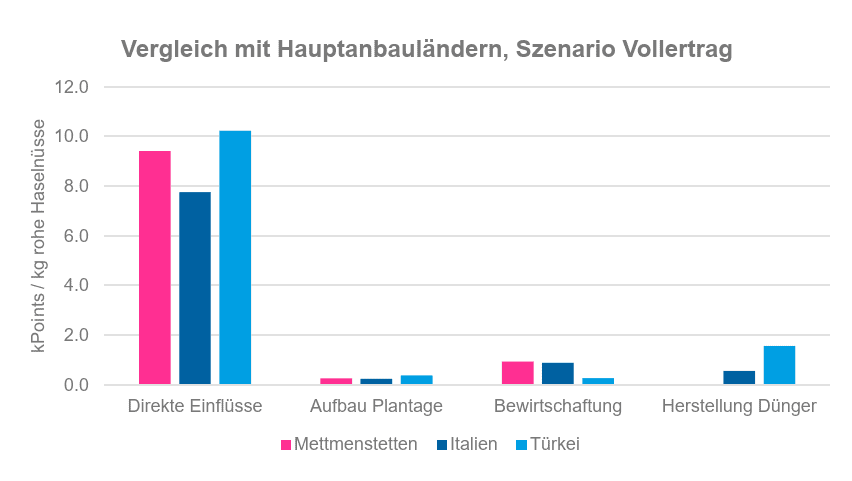
Why are the direct influences in Mettmenstetten high - despite organic farming?
The fertilizer used falls under "direct influences". Synthetic chemical fertilizers are used in Italy and Turkey. These have a lower heavy metal load than the average Swiss compost mix. We have used the database value of this mix in the life cycle assessment, although Stefan Gerber only uses organic compost. It can also be assumed that the heavy metal load of the Swiss compost mix will be reduced in the medium to long term through various measures. The environmental impact of compost is therefore rather high in our case.
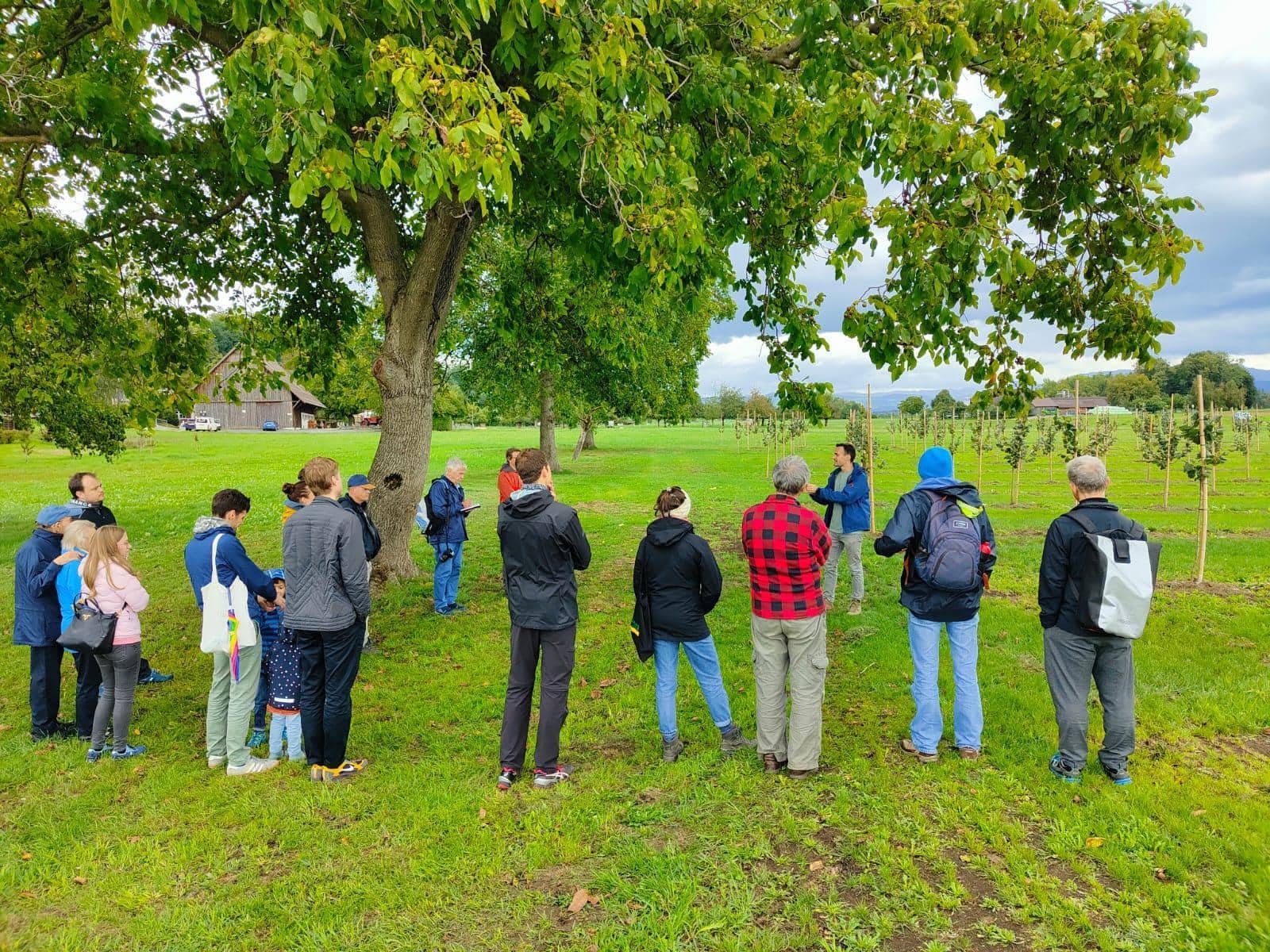
CO2-Fixation in the floor
But not only the greenhouse gas emissions and the environmental impact of a 250g bag of hazelnuts are important to find out to what extent hazelnuts can contribute to promoting climate-friendly agriculture. That is why we have also modeled how much CO2 can be stored in the soil through hazelnut cultivation. The good news first: hazelnut cultivation can store CO2 are stored in the soil. Compared to the previous forms of use (40% meadow and 60% arable land), this results in a fixation of -3.66 kg CO2e per kilogram of raw hazelnuts harvested.
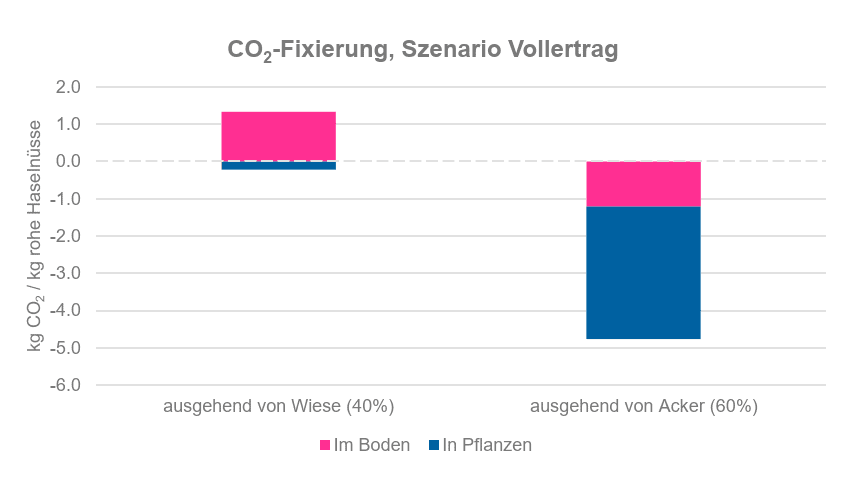
Unfortunately, we still can't simply plant heaps of hazelnut trees, thereby reducing CO2 in the ground and continue to emit greenhouse gases indefinitely. Why? Because the results only apply while the plantation is being established. Once the trees reach their full size, there is no more additional biomass build-up, so no additional CO2-fixation. From this point onwards (after approx. 20 years), a state of equilibrium is assumed: The release of CO2 The death of an old tree is balanced out by the growth of a new tree. A new balance has also been established in the soil, as there is no longer any change in the form of planting.
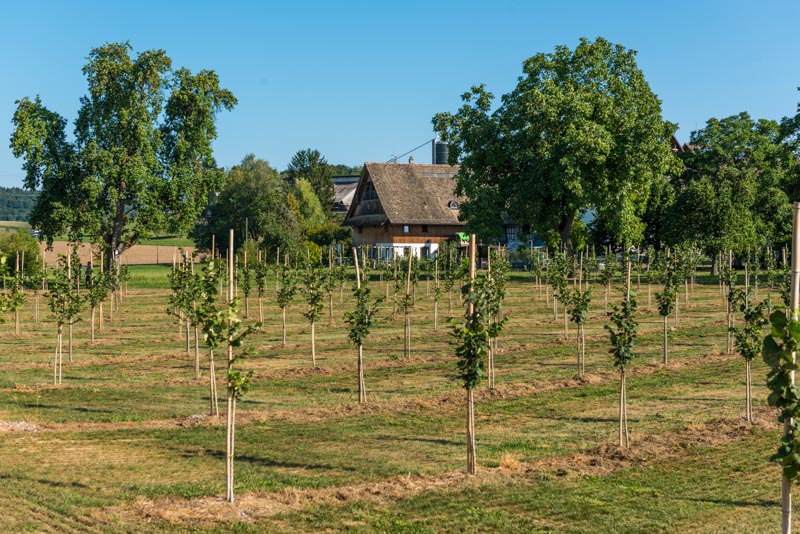
Conclusion
The decisive factor is not where the hazelnuts are grown, but how they are grown. Although Swiss hazelnuts have a lower environmental impact due to transportation (although there is still room for improvement here), the focus is on the cultivation phase. In absolute terms, hazelnut cultivation in Mettmenstetten performs best. However, the environmental impact per kilogram of hazelnuts is higher than for Italian hazelnuts due to the assumed lower harvest.
As soon as the hazelnut plantation is at full yield, the current assumptions must be reviewed again: If the harvest is larger than assumed, the environmental impact per kilogram of hazelnuts will also be lower. The heavy metal load from organic compost also needs to be examined again in detail.
In conclusion, it can be said: Yes, Swiss hazelnuts are a climate-friendly alternative, because a lot of CO2 is stored in the soil. However, this CO2-fixation is reversible. If hazelnuts are no longer cultivated in Mettmenstetten in the future and the trees are uprooted, the bound CO2. Together with Stefan Gerber, however, we will continue to pursue hazelnut cultivation not only in Mettmenstetten, but also throughout Switzerland.
Here to read the full report.
A really exciting report - thank you very much! And it's great that this project is being implemented in Switzerland, good luck to the initiators!
What always bothers me about such environmental analyses is the lack of an overall view. Of course, the carbon footprint is key, but there are so many other reasons to consume more regionally - first and foremost the social conditions. Hazelnut production in Turkey is repeatedly criticized for using child labour. Working conditions in Italy are also significantly worse in some cases. In addition, the use of pesticides is more clearly regulated in Switzerland.
We recently dedicated an article to this overall view in the Gantrisch Nature Park - read it here: https://www.gantrisch.ch/regionale-produkte-nachhaltige-produkte/
In addition, some time ago there was a very well researched article in the magazine "Reportagen" about hazelnut cultivation and its consequences in Italy: https://reportagen.com/reportage/wie-nutella-italien-frisst/ (unfortunately you need an account for this).
I am absolutely not against carbon footprints and understand that MyClimate focuses on them, but it would be desirable if the other aspects were also mentioned in at least one sentence in the blog post. Otherwise, thank you Crowd Container for your work!
Hello Katharina,
Thank you for your feedback and for sharing the links (the "Reports" link also worked for me without an account). As you rightly write in your article, the situation is certainly complex and an overall view is therefore very important! This is central to us at Crowd Container, which is why we create 100% transparency - from the field to the plate. For all our products from Switzerland, Sicily, Andalusia, Kerala and Peru, we know who produces them and how the actors involved are compensated. The focus is on the "how" (the products are grown and the people are paid) and less on the "where" (the products come from) - of course taking into account the conditions and cultivation cycles in the respective places. Find out more here: https://crowdcontainer.ch/ueber-uns/
We cover various areas with the hazelnut project, you can find all information about the project here: https://crowdcontainer.ch/projekte/lokale-haselnuesse/. Also because life cycle assessments do not include everything, we have examined biodiversity in more detail, for example: https://crowdcontainer.ch/wildbienen-lieben-haselnuesse/
A hearty ahoy,
Beni
Thanks for the clear summary! What I don't quite understand in the last section (conclusion): Is the CO2 bound in the soil really released if the hazel bushes would be replaced by another crop? Isn't the CO2 bound in the wood the more significant source of emissions if the shrubs are later chopped up and burned?
Hi Mike, thanks for your feedback and your question. As you rightly write, the burning of wood, in which CO2 is also bound, would be another source of emissions. However, the extent to which this is more significant than the release of CO2 bound in the soil cannot be conclusively assessed. There is no clear answer here because it depends on how the soil is managed after the hazelnut plantation. Depending on whether a forest is reforested, other crops are grown or a meadow is created, more or less carbon can be sequestered in the soil than with the hazelnut plantation.
The only question that remains for me is when will we get the first nuts from Crowd Container?
I'm already looking forward to it!
Hello Erhard, we were able to deliver a few packs of hazelnuts last year. If everything goes smoothly, we will be able to get hazelnuts from Stefan Gerber again this year. Delivery is expected in November.
Very differentiated, critical analysis! Comprehensible assessment of the advantages and disadvantages of producing hazelnuts in Mettmenstetten compared with growing them in Italy and Turkey.
A big compliment!
Should become more common in Swiss and neighboring agriculture, because nuts are nutritionally perfect as a substitute for animal production.
So good and informative! I especially love the complete honesty and transparency, even with your own project! Thank you!